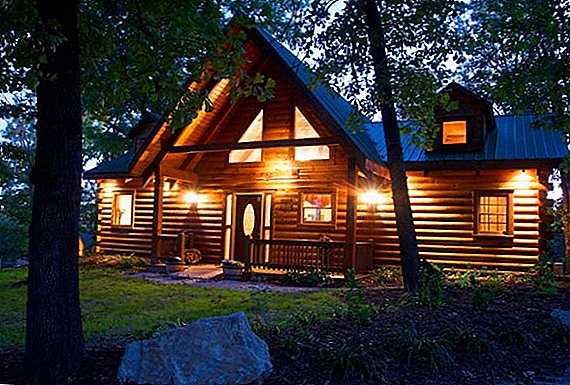 Illumination of a country house is one of the important components of its arrangement, therefore one should think about this issue at the design stage of the building. Depending on the functional purpose, there are several possible ways of organizing street lighting, which we describe below.
Illumination of a country house is one of the important components of its arrangement, therefore one should think about this issue at the design stage of the building. Depending on the functional purpose, there are several possible ways of organizing street lighting, which we describe below.
Types of street lighting
In fact, you can select a lot of ways to supply light, based on the location of the lamps, their type or a specific attachment point, but all this can be conventionally combined into several main groups: functional, decorative, marking and security lighting. 
Functional
Functional, that is, general lighting, provides for the installation of lighting elements in places of frequent movement of people: along the main paths, near the front door, gate, gate, entrance to the garage and various enclosing structures or outbuildings.
Of course, depending on the specific installation location, the most suitable fixtures are also selected.
For example, for the parking zone and main paths you can buy lanterns fixed on a pole that will exceed human height, and for lighting the gates and wickets, lamps that are installed on the end of the poles are more suitable.
Important! By placing the lights on top, it is possible to achieve illumination not only of the zone near the gate, but also of a part of the entrance or path, the main thing - pick up lights, directing the beam just down.

In any case, you should choose only high-quality optics, with practical gas-discharge lamps of sufficient power. The control of such elements is carried out either manually (using a knife switch) or automatically (by means of a timer, with a specific “twilight” time).
The power of the luminaires will directly depend on the reserves of a particular place, the width of the track itself or the distance between adjacent elements.
Decorative
This version of the lighting elements can be called the complete opposite of the previous one, because all the lamps and small lighting elements are aimed at improving the appearance of the inner space of the courtyard and are a manifestation of the individuality of the owner. 
At dusk, the individual illuminated parts of the house or other courtyard objects look more mysterious and attractive, and for organizing such an addition, lamps built into the ground, decorative supports with lanterns placed on them, underwater illumination, spotlights (usually installed to illuminate sculptures) or wall mounted are usually used. lights, fixing to different parts of the house.
Learn how beautifully you can improve and decorate the suburban area with your own hands, as well as how to make a sofa out of pallets, how to choose garden sculptures, how to make a decorative waterfall, garden swing, fountain, rose garden, flower bed of stones, rock arias, a dry stream, a flower garden from wheeled tire trellis for grapes.
To manage all these elements, the owner can either use the remote control located in the house, or simply set the activation time of a particular group of decorative lights.
Such lighting partially solves the question of visibility in the adjacent areas, because most often the reflected rays are enough to see the path and not stumble.
Marking
In many ways, this kind of lighting of a country site resembles a functional one, and the difference is only in more pointed illumination of certain important elements: steps, paths, paths for the entrance and exit of a car, etc. 
In this case, the light sources are installed on the posts and in the pavement, protecting them from possible mechanical and atmospheric damage by the impact-resistant casing. Marking lighting can be used continuously or be used only in a specific season, to increase the safety of movement of people and equipment.
Security guard
Security (or as it is also called "accompanying") lighting, provides for the installation of individual lighting elements that react to the movement next to them. That is, the light will light up in response to the sensor's reaction, which in most cases scares strangers.
These lamps are deservedly considered the most convenient, the main thing is to arrange them so that they fix all approaches to the entrance, without the slightest "dead zones". 
Security lighting can also serve to illuminate outbuildings, which is even more convenient, since it will no longer be necessary to turn the light on and off manually every time.
Installed security lights work for several minutes after fixing the movement, although in most models the user can independently program the most suitable operating time: from 5 to 30 minutes.
Did you know? Modern electricity originated as far back as 1802, when V.V. Petrov (the first electrical engineer) successfully conducted an experiment using a battery of galvanic elements that he had previously created.

Lighting system layout
Arrangement of outdoor lighting of a country house always begin with a detailed planning, which includes several successive stages:
- The decision of the technical side of the issue (all calculations relating to the quality indicators used lighting elements).
- Development of drawings for the organization of facade lighting (if such is provided) and the layout of the placement of external lighting elements on the site, with a detailed indication of the installation locations of lamps, cables and supporting structures.
- Drawing scheme of complex angles and the whole electrical supply.
- Selection of suitable lighting equipment, taking into account the required specifications.
- The calculation of energy consumed in the future, based on the data on the selected lighting elements and their quantity, which in turn serves as the basis for calculating the required amount of cable and circuit breakers.
Do not forget about some other nuances that should be paid attention at the planning stage. For example, the cable to be laid should run 30 cm above the surface of the soil or any other communication pipes (gas supply pipes should be placed even further - at least 60 cm). 
Also, experts do not recommend to pull it through the air, and in case of emergency, in addition to it, it is worthwhile to pull the steel cable in advance.
Important! The power cable for the lamps located on the wall should be installed before its final finishing, otherwise protective boxes will significantly affect the appearance of the house.
The buildings
In addition to a residential building, there may be other outbuildings in the suburban private territory that also need lighting. Of course, they will not become good decorative elements, but the contour illumination will mark the structure and hide the features of its appearance a little.
So, for the illumination of the garage and utility rooms, wall lights are ideal, which can indicate a specific place of entry or entry. 
An excellent option for such lighting elements will be energy-saving lamps with low power, which can be switched on both simultaneously and triggered by a motion sensor.
To provide good lighting in the economic zone will help floodlights, installed on specially selected supports or walls of the building. To control such lighting elements can be using a knife switch.
To illuminate the gazebo, most often the owners install lamps in the center of the roof, right under the ceiling, for which the ceiling lamp, complemented by a matt diffuser, is perfect (the main requirement: the light should not be too bright, filling the entire space of the gazebo).
If the building was erected using non-combustible materials, the moisture-proof switch of such lamps can be placed inside the arbor, otherwise it would be better if it was located in any capital construction. 
Did you know? The first street lamps appeared in 1417 and they were installed on the streets of London, which was the result of the order of the mayor Henry Barton.
Rest zone
In recreation areas a large crowd of people is observed even after sunset, and for comfortable communication a sufficient amount of light is simply necessary. Most often, experts recommend creating a general lighting here, exactly the same as in the house, except that, adding to its external illumination, for example, around the gazebo.
Learn how to make a gazebo for yourself, how to make a polycarbonate gazebo.
We mentioned earlier what lamps to use inside, but now we will pay attention to the lighting from the outside of the building. The ideal variant of the lighting system in this case would be a group of lamps of diffused light installed at a certain distance from the arbor itself. 
It can be small fixtures or rather large poles with lanterns on them, as long as any design fits in harmoniously with the overall design.
If there is a pool or another reservoir next to the gazebo, it can be illuminated with a contour illumination using lamps in a sealed enclosure. In a dotted way, you can illuminate all the paths that are in the recreation area.
Garden area
Recently, garden lighting is becoming more common, which is not surprising, given the prevalence of landscape design. It can be flood, contour, scattered or emphasize individual figures, making them an emphasis. The last two species are often combined with each other and complement each other favorably.
Flood view is appropriate when illuminating flower beds, meadows and curly plants, as well emphasizes all these elements and allows you to better view them from all sides. 
To achieve this effect, scattered luminaires are usually used, providing warm light (they are placed both along the contour and in the central part of the illuminated structure).
In contour lighting, the same LED elements can be used as to illuminate the facade, only in this case they are mounted not along the contour of the house, but along the edge of figure bushes and trees.
For the arrangement of the dacha, it will be useful for you to learn how to make a brazier out of stone, concrete walkways, a blind area at home, how to build a swimming pool, a summer shower.
Accented view is perfect for lighting some special compositions in the garden, so that they are clearly visible even in the evening. Usually they are decorative waterfalls, a protruding relief of the area, a part of a tree, or just a large or unusual stone, which only emphasizes the overall beauty of the garden.
Accented lighting can be arranged by using low aboveground lamps, the color of which is selected depending on the composition of the garden and varies from white to red and orange. 
Scattered light will be relevant for the entire garden, because its main purpose is the overall illumination, and not the selection of individual elements.
Also, this view is used to emphasize the irregularities of the terrain and the features of its structure, and the implementation of the task will help the installation of diffused light fixtures at a distance of about 30 cm from the ground. If you wish, you can install lighting elements in specially arranged niches or pits from which light will subsequently flow.
Important! When installing fixtures in trenches, protect them from being washed away with groundwater or backfilling with earth.
House facade lighting
Illumination of the facade of the house is not the most common method of lighting, since it is not aimed at a good overview of the territory, but at an emphasis on the dwelling itself, which some owners consider to be a useless addition. 
However, this position does not negate the fact that it is a great way to highlight the beautiful components and hide the less attractive parts of the residential structure, sometimes even giving it a truly fabulous shape.
There are several options for facade lighting: flooded, accented, contour, hidden or mixed (combines several of these types at once).
By choosing a flood view, you can illuminate the walls of the house from all sides, simply by installing scattered and directed lighting elements near the soil surface or on the projecting parts of the building (in this case it is recommended to choose warm colors that will help to visually bring it closer).
Accented view is suitable for those who want to favorably select only decorative elements: statues, frescoes, columns or other additions in the facade of the house. For these purposes, directional lamps are usually used, installed both on the ground surface and on the facade itself, or under the roof. 
Color in this case does not play a significant role, as long as it fits into the overall design and is well combined with other variations of the lighting on the site.
The contour illumination of the facade is performed using diode ribbons that are installed next to the individual parts: they are easily attached to the protruding or contoured parts of the building.
From the point of view of the color palette, this option will be the most successful, since the owner can change the color of the glow manually or set a timer, which will somewhat diversify the appearance of your home and bring in a certain highlight.
As for the hidden lighting, it is used only if there are protruding elements of the structure, and the principle of its operation and organization requirements are similar to similar features of the ceiling lighting inside the building, and only the dimensions are different. 
Whatever it was, but before buying lamps, think carefully about where and how you will install them, because even the lightest glow can spoil the appearance of the backyard territory, while consuming a lot of energy.












